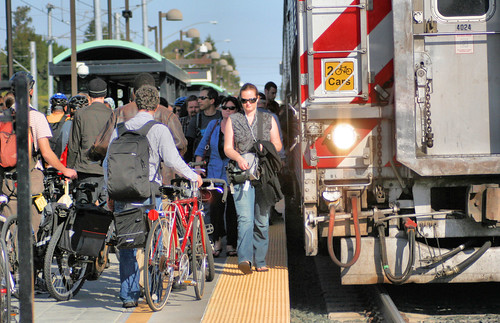This is a guest post by Scott Lane.
As gas prices keep escalating, many people are turning away from cars as their primary mode of transportation. For a growing minority of us it is a combination of cars, bikes and buses. For those that like exercise and need to make the first and last leg of their commute faster than walking, biking is a good alternative.
The great news is that more are riding. The bad news is sometimes there is no room for bikes on the bus.

Most buses reach their bike carrying capacity with just 2 bicycles.
During non-commute hours this is normally not an issue on most bus lines. But on many “backbone” bus lines only having the ability to secure two bikes on the front of a bus simply doesn’t work. Then what? Some agencies allow bikes to be brought on board, but this is according to the judgment of the individual driver. This may not sound like a big deal until 2-3 buses in a row already have the (2 bike) front bike rack already full.
You’ll have a much better chance to get your bikes onto trains and light rail as these modes have more room to accomodate them.
In the SF Bay Area it was advocates that have pushed CalTrain to drastically introduce capacity. Some are pushing BART to loosen restrictions as well.
On buses it is much harder to solve this issue than on light rail and trains. Most buses only have capacity for two bikes on the front of buses, with no permanent/semi-permanent interior bike capacity.
A wonderful exception to this generalization can be seen on the Santa Cruz Metro/VTA/Amtrak Highway 17 Express — a popular route that travels over Highway 17 between San Jose and Santa Cruz. It has three slots on the front and additional capacity inside for two more. But still, sometimes all of the exterior and interior capacity is filled, requiring bike riders to wait for the next bus. On two occasions the driver allowed an additional bike inside the bus (only because I offered to help arrange the bikes into a more tightly packed configuration).
The key question is how can we increase bicycle capacity without significantly affecting the non-biking riders? And how can these bikes be loaded where they don’t affect the ingress/egress. Or become possible theft targets.
- added bike racks/storage lockers at bus stops
- added external bike capacity
- added internal bike capacity
These three examples are meant to engage conversation. Each has very obvious limitations, which can be found here. There certainly are other possibilites, many of which might be much better than the three listed here. What are your suggestions?
There is much research on this and blogs that have been looking into “Bikes on Board” buses, light rail and trains.
Research: Rutgers, LA Metro/Alta, MTI, FHWA and McGill
Blogs: Bike restrictions in NYC area, BicyclingInfo, StevenCanPlan, TheCityFix, BikePortland and a google search for Bikes On Board
About the author:
Scott Lane is an avid bicyclist, trail user and user of local alternative transportation.
He is involved in local non-profits in the Santa Clara Valley that support non-automotive transportation.
Become a Contributor, Write a Guest Post
For more information check out the Get Involved page here, or from the site’s header.



7 Comments
Swiss have this on Trams and Trains – special section or whole car for this – with passenger seats.
Busses too…
This. I don’t see why they couldn’t add a trailer to a bus as well.
I have to say that’s a pretty smart design
Folding bikes that you can carry on like luggage can also extend the number of bikes on a bus. I regularly see them on Caltrain. I’ve seen people ride critical mass on them to. They don’t really have the range for serious riding, but they are excellent for solving that last mile problem.
Yes, but the the lighter and easier to carry the more expensive they are
Europe : bus trailers are seldom used , notably on mid-range bus routes in the alps, but are a big nuisance in city traffic (particularly in historical cities small roads) and require a different driving licence respect std bus.
A not-so-small trailed or pushed wagon could instead be an good solution for trams and LRT – practically all small swiss railways use them as well the funiculars